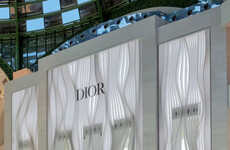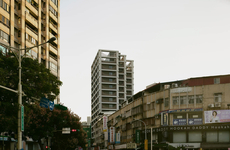
The Cluj-Napoca Art Center Breaks Down the Architectural Norm
Amelia Roblin — June 29, 2011 — Art & Design
References: suckerpunchdaily
A full facade of curtainwall windows was impressive back in the 1930s, but a team of two architecture students have come up with the Cluj-Napoca Art Center in Romania and a new style of cladding for commercial buildings.
The glass box has reigned for decades, and Horea Racasan and Andrei Vlas offer up a more liberal treatment of geometry. Seemingly opposed to the idea of right angles and rational corners, the pair have created glossy elevations that appear much like haphazardly cut diamonds.
Contemporary clarity is achieved through this creative approach to catching light, for reflection is this structure's specialty. Complementing the old brick mosque beneath colossal floating gems, the pixelated Cluj-Napoca Art Center deconstructs its own futuristic form with shattering frames that break up each mirrored face.
The glass box has reigned for decades, and Horea Racasan and Andrei Vlas offer up a more liberal treatment of geometry. Seemingly opposed to the idea of right angles and rational corners, the pair have created glossy elevations that appear much like haphazardly cut diamonds.
Contemporary clarity is achieved through this creative approach to catching light, for reflection is this structure's specialty. Complementing the old brick mosque beneath colossal floating gems, the pixelated Cluj-Napoca Art Center deconstructs its own futuristic form with shattering frames that break up each mirrored face.
Trend Themes
1. Glossy Elevations - Opportunity for architects and designers to experiment with unconventional and irregular forms of glass facades, creating visually stunning structures.
2. Pixelated Architecture - Potential for using fragmented glass facades to create unique and dynamic pixelated patterns on buildings, adding a sense of modernity and innovation.
3. Deconstructed Form - Innovative opportunity to break away from traditional architectural norms by deconstructing the form of structures and creating visually striking compositions with fragmented glass facades.
Industry Implications
1. Architecture - Architects can explore the use of fragmented glass facades to create bold and visually captivating designs in commercial and public buildings.
2. Design - Designers can incorporate fragmented glass facades in their projects to add a sense of creativity and innovation, pushing the boundaries of traditional design principles.
3. Construction - Construction companies can embrace the use of fragmented glass facades to offer clients a unique and modern approach to building design, setting themselves apart in the industry.
4.2
Score
Popularity
Activity
Freshness























